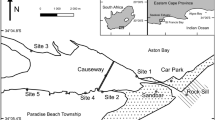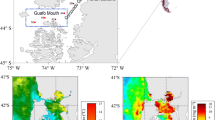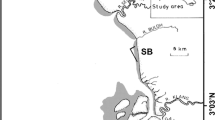Abstract
A fine-mesh seine net was used at regular intervals to collect fishes from the entrance channel and basin of the Blackwood River Estuary (south-western Australia), from Deadwater Lagoon, which is joined to the entrance channel by a narrow and shallow water-course and thus constitutes part of this estuary, and from Flinders Bay into which the estuary discharges. Sampling was at six-weekly intervals between February and December 1994. The juveniles of some marine species, such as Pelates sexlineatus, Rhabdosargus sarba and Aldrichetta forsteri, were either found only in the estuary or were in far higher densities in the estuary than in Flinders Bay. In contrast, the juveniles of some other marine species, such as Sillago schomburgkii, were relatively abundant in both environments, while others such as S. bassensis, Pelsartia humeralis, Lesueurina platycephala and Spratelloides robustus were either far more abundant in Flinders Bay or entirely restricted to this marine embayment. The various marine species found in inshore waters thus apparently vary considerably in their “preference” for estuaries as nursery areas. Although some marine species were abundant in the shallows of the estuary, the fish fauna of these waters was dominated by the estuarine-spawning species Leptatherina wallacei, Favonigobius lateralis, L. presbyteroides and Atherinosoma elongata. The above regional differences help account␣for the very marked difference that was found between the compositions of the shallow-water␣ichthyofaunas of Flinders Bay and each of the three estuarine regions. The ichthyofaunal compositions of the basin and channel underwent pronounced changes during winter, when freshwater discharge increased markedly and salinities in the estuary thus declined precipitously. This faunal change was mainly attributable to the emigration of marine stragglers, a reduction in the densities of marine estuarine-opportunist species such as Pelates sexlineatus and R. sarba, and the immigration of large numbers of both young 0+ Aldrichetti forsteri from the sea and of L. wallacei from the river. Although most of the above species were also abundant in Deadwater Lagoon, the ichthyofaunal composition of this region did not undergo the same seasonal changes, presumably due to the lack of riverine input and thus the maintenance of relatively high salinities throughout the year. The number of marine straggler species was much lower in Deadwater Lagoon than in the estuary basin, reflecting a far more restricted tidal exchange with the entrance channel. However, the overall density of fishes was far higher in Deadwater Lagoon than in the estuary basin or entrance channel, due mainly to the far higher densities of the estuarine species Atherinosoma elongata and L. wallacei and of the 0+ age class of the marine species R. sarba. The high densities of certain species in Deadwater Lagoon are assumed to be related, at least in part, to the high level of productivity and protection that is provided by the presence of patches of Ruppia megacarpa, an aquatic angiosperm that was not present in the estuary basin or entrance channel.
Similar content being viewed by others
Author information
Authors and Affiliations
Additional information
Received: 3 December 1996 / Accepted: 19 December 1996
Rights and permissions
About this article
Cite this article
Valesini, F., Potter, I., Platell, M. et al. Ichthyofaunas of a temperate estuary and adjacent marine embayment. Implications regarding choice of nursery area and influence of environmental changes. Marine Biology 128, 317–328 (1997). https://doi.org/10.1007/s002270050097
Issue Date:
DOI: https://doi.org/10.1007/s002270050097




